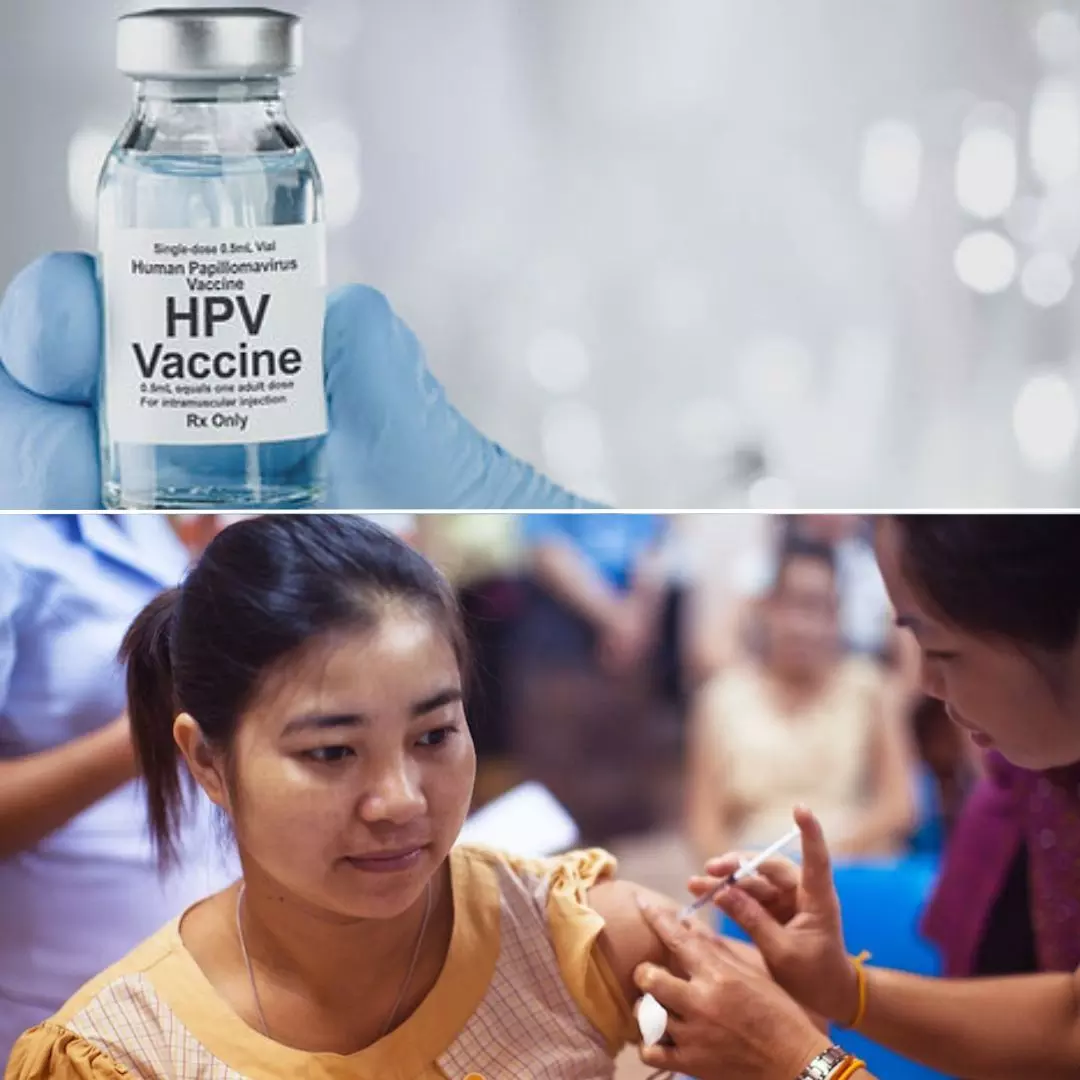HPV Vaccines: All You Need To Know About Cure & Prevention Of Leading Cancer Among Indian Women
Writer: Laxmi Mohan Kumar
She is an aspiring journalist in the process of learning and unlearning many things. Always up for discussions on everything from popular culture to politics.
India, 19 Jan 2023 7:49 AM GMT
Editor : Jayali Wavhal |
She writes about gender issues, human interest, and environment.
Creatives : Laxmi Mohan Kumar
She is an aspiring journalist in the process of learning and unlearning many things. Always up for discussions on everything from popular culture to politics.
Cervical cancer, the most common cancer that affects women in the country and worldwide, is a preventable and curable cancer if detected and treated early. However, it still continues to be shrouded by a lack of awareness and stigma surrounding sexually transmitted diseases.
Every new year starts with a reminder to prioritise health and take needful measures to prevent diseases. Playing a part in taking this message to the people, the World Health Organisation (WHO) observed the first month of the year, January, as Cervical Cancer Awareness month. WHO declared the month as an opportunity to raise awareness about the cancer that is among the most common cancers among women. Somehow a lot of women continue to be kept in the dark regarding preventive measures and the need to take Human Papillomavirus Vaccine (HPV). In an attempt to address the lack of awareness and the stigma attached to HPV, The Logical Indian looks into the prevalence, prevention, and available vaccines in the country.
Cervical Cancer In India
Cervical cancer, caused by the Human Papillomavirus infection, is leading cancer in Indian women and the second most common cancer in women worldwide. Across the world, the incidence of cervical cancer is about 5,10,000 cases annually, with approximately 288,000 deaths. In India, out of a population of approximately 365.71 million women, about 1,32,000 new cases are diagnosed, and 74,000 deaths occur annually, accounting for nearly 1/3rd of the global cervical cancer deaths.
Unlike other types of cancers, cervical cancer strikes early at the productive period of a woman's life and peaks around the ages of 50 to 65 years. Estimates suggest that more than 80 per cent of sexually active women acquire genital HPV by 50 years of age.
Despite its prevalence, not many are aware of the preventive measures and vaccines that can safeguard women from the risks of such cancers. Among the available preventive measures, prevention by vaccination is emerging as the most effective option. Over the years, many studies and tests were conducted to understand the vaccine's efficacy, immunogenicity and safety, and they have been recommended in the majority of them as a solution to prevent cervical cancer.
Currently, efforts have been focused on research programmes directed toward understanding the virus and prevention better in the country. The National cancer registry programme, established by the Indian council of medical research, acts as a surveillance system for this cancer and has been effectively collecting data from government and private sector hospitals and pathology laboratories.
Preventing HPV
Cervical cancer might be in treatable forms, so understanding the signs and getting it treated early is important. However, due to the lack of awareness, particularly in rural spaces, it has been commonly seen growing among rural women. Many experts have also traced the prevalence of cervical cancer among rural women to early marriage and early sexual relationships at a young age. Among the most common symptoms that convey the possibility of cervical cancer are vaginal bleeding after intercourse, pelvic pain during intercourse, genital warts, and vaginal discharge.
HPV transmission is influenced by sexual activity and age, making almost 75 per cent of all sexually active adults to be likely to be infected with at least one HPV type. These infections, however, resolve spontaneously, and only a minority (<1%) of HPV infections progress to the stage of cancer. For most HPV infections to progress to cancer, there are also multiple cofactors in play, such as long-term use of hormonal contraceptives, high parity, early initiation of sexual activity, multiple sex partners, tobacco smoking and co-infection with HIV, poor hygiene, and a diet low in antioxidants, among others. Regardless of the low per cent, the lifetime risk for genital HPV is still accounted to be around 50 to 80 per cent.
Vaccines Available In India
In India, currently, large-scale routine screening for HPV infections is difficult to achieve and not many attempt to screen it as it is either asymptomatic or due to the stigma that follows with cervical cancer. To combat this, vaccines are considered among the best preventive measures. There are various types of vaccines, and in the country, one can find two common vaccines that are licensed globally. These are a quadrivalent vaccine (Gardasil marketed by Merck) and a bivalent vaccine (Cervarix marketed by Glaxo Smith Kline).
The Gardasil vaccine is a mixture of L1 proteins of HPV serotypes 16, 18, 6 and 11, and the clinical trials had shown 100 per cent efficacy at a median follow-up of 1.9 years against types 16/18. The trials with three doses of the vaccine were conducted among more than 16,000 women aged 16 to 26 years from five continents, including Asia. The vaccine proved to provide protection against both cervical cancer and genital warts.
Cervarix, on the other hand, is a mixture of L1 proteins of HPV serotypes 16 and 18 with AS04 as an adjuvant. Clinical trials were said to have been conducted among over 18,000 women globally, and it showed 90 per cent efficacy against type 16/18-related CIN-2/3 and AIS after a 15-month follow-up. According to an article by the Indian Journal of Medical and Paediatric Oncology, the vaccine only provides protection against cervical cancer.
The recommended age for administering these vaccines is 9–12 years. After which, a follow-up vaccination is permitted up to the age of 26. The vaccine is currently not licensed for use in female patients younger than nine or older than 26 and is also not administered to male patients. A total of three doses are recommended within the gap of 0, 2 and 6 months for Gardasil™ or 0, 1 and 6 months for Cervarix. Even if the vaccine schedules are interrupted, they can proceed with it without restarting the entire process.
Just a month ago, the Indian Government announced that they would be providing vaccines for the prevention of cervical cancer to girls aged between 9 and 14 through their schools. According to a report by The Hindu, the decision was based on the National Technical Advisory Group for Immunisation (NTAGI) recommendation to introduce the HPV Vaccine under the Universal Immunisation Programme. Based on these recommendations, the schools were directed to provide the vaccines as a mandate. Following the announcement, the Government also conveyed that the country is expecting to roll out the indigenously developed CERVAVAC vaccine by mid-2023 to combat cervical cancer cases.
Commonly Observed Side Effects Of HPV Vaccine
Side effects and reactions follow any form of vaccination as it introduces a strain that is foreign to the immune system. In regard to the HPV Vaccine, the most common adverse reactions are pain (mild to moderate), swelling, and fever, among others. No serious vaccine-related adverse events have been reported so far from the studies conducted worldwide, except for people with a history of immediate hypersensitivity to any vaccine component. It is also not recommended to be used on pregnant women due to the limited data surrounding it. However, lactating women and immunosuppressed female patients can receive the vaccine, but the efficacy and the degree of immune response could be poor among the immunosuppressed group.
Also Read: Cervavac: India's Vaccine Against Cervical Cancer For Girls Aged 9 to 14 To Roll Out Next Year
 All section
All section















